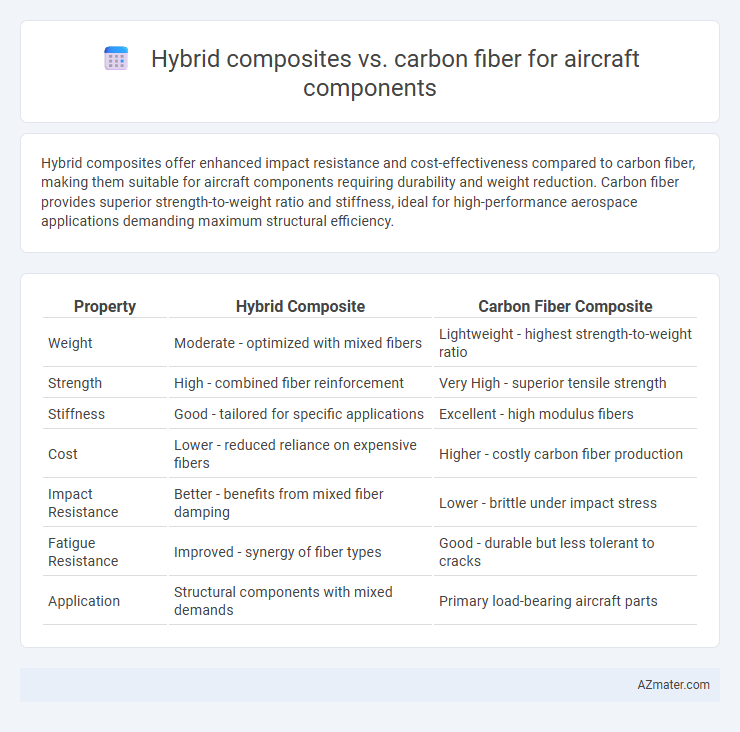Hybrid composites offer enhanced impact resistance and cost-effectiveness compared to carbon fiber, making them suitable for aircraft components requiring durability and weight reduction. Carbon fiber provides superior strength-to-weight ratio and stiffness, ideal for high-performance aerospace applications demanding maximum structural efficiency.
Table of Comparison
| Property | Hybrid Composite | Carbon Fiber Composite |
|---|---|---|
| Weight | Moderate - optimized with mixed fibers | Lightweight - highest strength-to-weight ratio |
| Strength | High - combined fiber reinforcement | Very High - superior tensile strength |
| Stiffness | Good - tailored for specific applications | Excellent - high modulus fibers |
| Cost | Lower - reduced reliance on expensive fibers | Higher - costly carbon fiber production |
| Impact Resistance | Better - benefits from mixed fiber damping | Lower - brittle under impact stress |
| Fatigue Resistance | Improved - synergy of fiber types | Good - durable but less tolerant to cracks |
| Application | Structural components with mixed demands | Primary load-bearing aircraft parts |
Introduction to Aircraft Composite Materials
Aircraft components increasingly utilize hybrid composites combining carbon fiber with other fibers to enhance strength, stiffness, and impact resistance compared to traditional carbon fiber alone. Carbon fiber composites offer exceptional weight-to-strength ratios and corrosion resistance, making them ideal for critical structural parts like fuselage and wing elements. Hybrid composites optimize performance by balancing carbon fiber's high modulus with complementary materials, improving durability and fatigue life in aerospace applications.
Understanding Hybrid Composites
Hybrid composites combine carbon fibers with other materials such as glass or aramid fibers to optimize strength, weight, and impact resistance in aircraft components. These composites offer tailored mechanical properties and enhanced fatigue performance compared to pure carbon fiber, making them suitable for critical structural parts subjected to varied loading conditions. Understanding the balance between stiffness, toughness, and cost-efficiency in hybrid composites enables aerospace engineers to design lighter, more durable aircraft components.
Overview of Carbon Fiber Composites
Carbon fiber composites offer exceptional strength-to-weight ratios and high stiffness, making them ideal for aircraft components that require durability and lightweight properties. These composites consist of carbon fibers embedded in a polymer matrix, providing superior fatigue resistance and corrosion resistance compared to traditional materials. Their widespread use in aerospace structures enhances fuel efficiency and performance by significantly reducing the overall weight of the aircraft.
Mechanical Properties Comparison
Hybrid composites combine different fiber materials to optimize tensile strength, impact resistance, and fatigue behavior, often surpassing pure carbon fiber in toughness and damage tolerance. Carbon fiber exhibits superior specific strength and stiffness, making it ideal for high-performance aircraft components requiring lightweight and rigid structures. Mechanical property trade-offs include enhanced impact resistance and energy absorption in hybrids versus the high modulus and lower density characteristic of carbon fiber composites.
Weight and Performance Analysis
Hybrid composites combining carbon fiber with materials like glass or aramid fibers offer a balance between weight reduction and enhanced damage tolerance, making them suitable for certain aircraft components requiring impact resistance and fatigue strength. Carbon fiber composites provide superior stiffness-to-weight ratio and higher tensile strength, resulting in greater overall performance and fuel efficiency in primary structural parts. Weight savings from carbon fiber directly contribute to improved aircraft range and payload capacity, while hybrid composites optimize cost and durability without significantly compromising weight.
Cost Effectiveness and Availability
Hybrid composite materials offer a cost-effective alternative to pure carbon fiber for aircraft components due to lower raw material costs and reduced manufacturing complexity, enabling more budget-conscious production without significantly compromising strength. Carbon fiber, while providing superior strength-to-weight ratios and stiffness, remains expensive and is less readily available in large quantities, which can limit its use in extensive structural applications. The strategic integration of hybrid composites can optimize both performance and cost-efficiency, making them more accessible for a broader range of aerospace manufacturing needs.
Durability and Environmental Resistance
Hybrid composites combine carbon fiber with other materials such as glass or aramid fibers, enhancing durability by improving impact resistance and reducing brittleness compared to pure carbon fiber composites used in aircraft components. Carbon fiber offers superior strength-to-weight ratio and stiffness but can be more susceptible to damage from moisture and UV exposure, necessitating protective coatings for environmental resistance. Hybrid composites provide a balanced performance, delivering enhanced durability and better resistance to environmental factors like corrosion and temperature fluctuations critical for aircraft structural integrity.
Manufacturing and Processing Considerations
Hybrid composite materials offer enhanced manufacturing flexibility by combining fibers like carbon and glass, enabling tailored mechanical properties and reduced costs compared to pure carbon fiber, which requires precise handling to maintain fiber alignment and resin impregnation for optimal strength. Processing carbon fiber components demands stringent conditions such as controlled curing cycles and autoclave use to achieve desired performance, while hybrid composites allow more adaptable curing processes and often lower temperature requirements. Manufacturing efficiency improves with hybrids due to reduced tool wear and easier repair, whereas carbon fiber's brittleness and sensitivity to processing defects necessitate stricter quality control and specialized equipment.
Applications in Modern Aircraft Components
Hybrid composites combine carbon fiber with other fibers like glass or aramid to enhance impact resistance and reduce weight in aircraft components, making them ideal for fuselage panels and interior structures. Carbon fiber offers superior strength-to-weight ratio and stiffness, frequently used in critical load-bearing elements such as wing spars and engine nacelles. Modern aircraft leverage hybrid composites for cost-effective durability while relying on carbon fiber for high-performance structural parts requiring maximum strength and fatigue resistance.
Future Trends in Aerospace Composite Materials
Hybrid composites combine different fibers, such as carbon and glass, to optimize strength, weight, and cost, making them increasingly attractive for aircraft components requiring tailored mechanical properties. Carbon fiber remains a dominant material due to its exceptional stiffness-to-weight ratio and fatigue resistance, crucial for critical aerospace structures. Future trends emphasize enhanced hybridization techniques, nanomaterial integration, and sustainable resin systems to improve performance, durability, and environmental impact in next-generation aerospace composite materials.

Infographic: Hybrid composite vs Carbon fiber for Aircraft component
 azmater.com
azmater.com